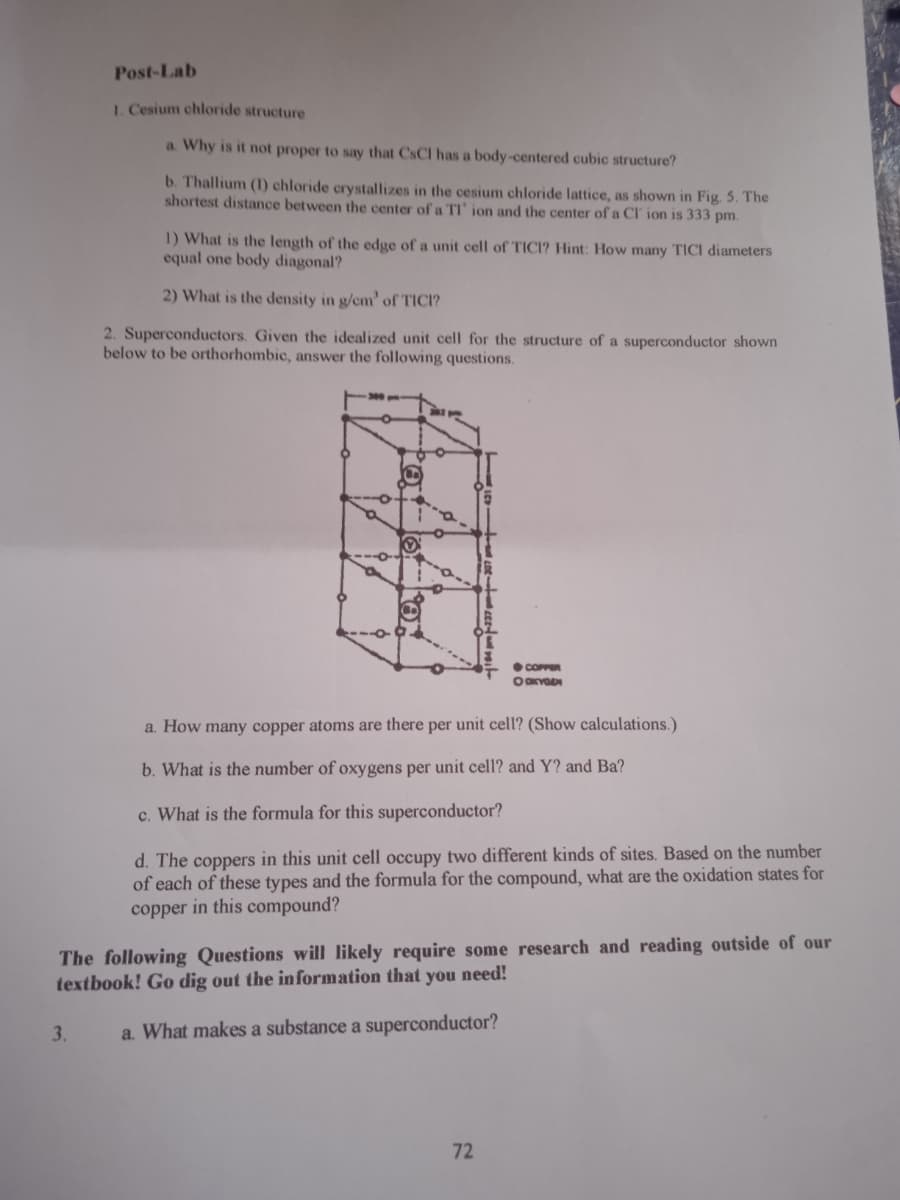Post-Lab 1. Cesium chloride structure a Why is it not proper to say that CSCI has a body-centered cubic structure? b. Thallium (1) chloride crystallizes in the cesium chloride lattice, as shown in Fig. 5. The shortest distance between the center of a TI' ion and the center of a CI ion is 333 pm. 1) What is the length of the edge of a unit cell of TICI? Hint: How many TICI diameters equal one body diagonal? 2) What is the density in g/cm' of TICI?
Post-Lab 1. Cesium chloride structure a Why is it not proper to say that CSCI has a body-centered cubic structure? b. Thallium (1) chloride crystallizes in the cesium chloride lattice, as shown in Fig. 5. The shortest distance between the center of a TI' ion and the center of a CI ion is 333 pm. 1) What is the length of the edge of a unit cell of TICI? Hint: How many TICI diameters equal one body diagonal? 2) What is the density in g/cm' of TICI?
General Chemistry - Standalone book (MindTap Course List)
11th Edition
ISBN:9781305580343
Author:Steven D. Gammon, Ebbing, Darrell Ebbing, Steven D., Darrell; Gammon, Darrell Ebbing; Steven D. Gammon, Darrell D.; Gammon, Ebbing; Steven D. Gammon; Darrell
Publisher:Steven D. Gammon, Ebbing, Darrell Ebbing, Steven D., Darrell; Gammon, Darrell Ebbing; Steven D. Gammon, Darrell D.; Gammon, Ebbing; Steven D. Gammon; Darrell
Chapter11: States Of Matter; Liquids And Solids
Section: Chapter Questions
Problem 11.157QP: Nanotechnology, or technology utilizing 1100 nm sized particles, has rapidly expanded in the past...
Related questions
Question
100%

Transcribed Image Text:Post-Lab
1. Cesium chloride structure
a. Why is it not proper to say that CSCI has a body-centered cubic structure?
b. Thallium (1) chloride crystallizes in the cesium chloride lattice, as shown in Fig. 5. The
shortest distance between the center of a TI' ion and the center of a CI ion is 333 pm.
1) What is the length of the edge of a unit cell of TICI? Hint: How many TICI diameters
equal one body diagonal?
2) What is the density in g/cm' of TICI?
2. Superconductors. Given the idealized unit cell for the structure of a superconductor shown
below to be orthorhombic, answer the following questions.
COPPR
a. How many copper atoms are there per unit cell? (Show calculations.)
b. What is the number of oxygens per unit cell? and Y? and Ba?
c. What is the formula for this superconductor?
d. The coppers in this unit cell occupy two different kinds of sites. Based on the number
of each of these types and the formula for the compound, what are the oxidation states for
copper in this compound?
The following Questions will likely require some research and reading outside of our
textbook! Go dig out the information that you need!
3.
a. What makes a substance a superconductor?
72
Expert Solution
This question has been solved!
Explore an expertly crafted, step-by-step solution for a thorough understanding of key concepts.
Step by step
Solved in 2 steps with 2 images

Knowledge Booster
Learn more about
Need a deep-dive on the concept behind this application? Look no further. Learn more about this topic, chemistry and related others by exploring similar questions and additional content below.Recommended textbooks for you

General Chemistry - Standalone book (MindTap Cour…
Chemistry
ISBN:
9781305580343
Author:
Steven D. Gammon, Ebbing, Darrell Ebbing, Steven D., Darrell; Gammon, Darrell Ebbing; Steven D. Gammon, Darrell D.; Gammon, Ebbing; Steven D. Gammon; Darrell
Publisher:
Cengage Learning

Chemistry: Principles and Reactions
Chemistry
ISBN:
9781305079373
Author:
William L. Masterton, Cecile N. Hurley
Publisher:
Cengage Learning

Chemistry for Engineering Students
Chemistry
ISBN:
9781337398909
Author:
Lawrence S. Brown, Tom Holme
Publisher:
Cengage Learning

General Chemistry - Standalone book (MindTap Cour…
Chemistry
ISBN:
9781305580343
Author:
Steven D. Gammon, Ebbing, Darrell Ebbing, Steven D., Darrell; Gammon, Darrell Ebbing; Steven D. Gammon, Darrell D.; Gammon, Ebbing; Steven D. Gammon; Darrell
Publisher:
Cengage Learning

Chemistry: Principles and Reactions
Chemistry
ISBN:
9781305079373
Author:
William L. Masterton, Cecile N. Hurley
Publisher:
Cengage Learning

Chemistry for Engineering Students
Chemistry
ISBN:
9781337398909
Author:
Lawrence S. Brown, Tom Holme
Publisher:
Cengage Learning